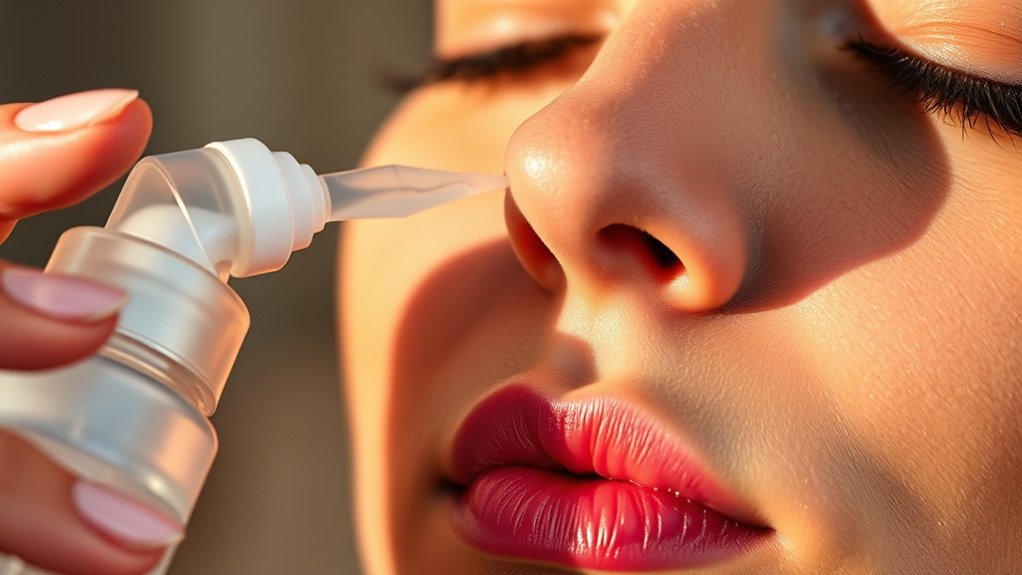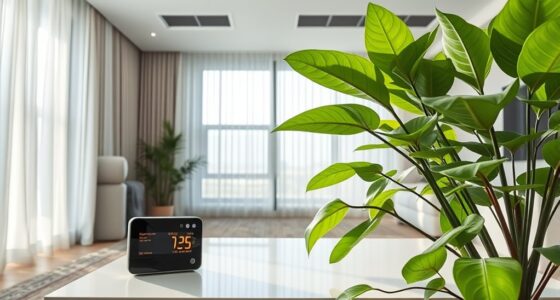Nasal irrigation helps clear mucus, allergens, and irritants from your nasal passages, relieving congestion and easing breathing. It flushes out thick mucus, reduces inflammation, and keeps nasal tissues moist. Using a simple technique with a neti pot or squeeze bottle, you tilt your head, insert the device, and gently rinse with saline solution. Proper equipment and precautions are key—if you’d like to learn more about how to do it safely and effectively, keep exploring.
Key Takeaways
- Nasal irrigation clears mucus, allergens, and irritants, reducing congestion and improving airflow.
- Proper technique involves tilting the head, inserting the device, and gently rinsing each nostril.
- Regular rinsing can lower infection risk, alleviate allergy symptoms, and keep nasal tissues moist.
- Use sterile, saline solutions and clean equipment to prevent infections and irritation.
- Seek medical advice if experiencing pain, bleeding, or worsening symptoms during nasal irrigation.
How Nasal Irrigation Can Relieve Congestion and Improve Breathing

Nasal irrigation effectively clears mucus and allergens from your nasal passages, making it easier to breathe. When you use a saline rinse, you wash away thick mucus that can block airflow. This process helps reduce nasal congestion caused by colds, allergies, or sinus issues. As you irrigate, the saline solution flushes out irritants and reduces inflammation in your nasal passages. You’ll notice relief as your sinuses open up, allowing for smoother, less labored breathing. Regular rinsing can prevent mucus buildup from becoming severe, keeping your nasal passages clear throughout the day. With consistent use, nasal irrigation can notably diminish the feeling of stuffiness and improve overall breathing comfort, especially during allergy season or when dealing with respiratory irritants. Additionally, the practice supports airway health by maintaining clear nasal passages and reducing the risk of infection.
The Health Benefits of Regular Nasal Rinsing

Regular nasal rinsing offers numerous health benefits that can enhance your overall well-being. By regularly flushing out mucus and irritants, you reduce the risk of infections and allergies. This practice helps clear allergens, dust, and pollutants from your nasal passages, making breathing easier and more comfortable. It also keeps your nasal tissues moist, preventing dryness and irritation, especially during dry seasons or in air-conditioned environments. Consistent rinsing can boost your immune response by removing bacteria and viruses before they cause illness. Additionally, it may decrease dependency on medications like decongestants, promoting natural relief. Incorporating nasal rinsing into your routine supports better respiratory health, reduces discomfort, and contributes to a clearer, healthier nasal environment. Nasal health maintenance can also contribute to overall wellness by supporting better sleep and reducing snoring caused by nasal congestion.
Step-by-Step Guide to Proper Nasal Lavage Technique

To perform nasal lavage effectively, it’s important to follow a proper technique that guarantees thorough cleansing and safety. Start by tilting your head forward slightly and to one side over the sink. Insert the spout of your device into the upper nostril, aiming it toward the back of your nasal cavity. Squeeze the saline solution gently, allowing it to flow through your nasal passages and out the other nostril. Breathe steadily through your mouth during the process. Once finished, blow your nose gently to clear any remaining solution or mucus. Repeat the process on the other side. Keep your movements gentle, and avoid applying too much pressure, to prevent discomfort or injury. HEPA filtration can help remove airborne irritants, supporting overall nasal health. Consistency and proper technique maximize the benefits of nasal irrigation.
Tips for Choosing the Right Equipment and Solutions

Choosing the right equipment and solutions can make a significant difference in how comfortable and effective your nasal irrigation routine is. To guarantee you get the best results, consider these tips:
- Select a device that fits your comfort level—whether a neti pot, squeeze bottle, or bulb syringe.
- Use sterile, pre-mixed saline solutions or make your own with clean water and salt.
- Opt for a solution with the right salt concentration—generally around 0.9%—to avoid irritation.
- Ensure the equipment is easy to clean and dry to prevent bacteria buildup.
- Understanding proper net worth growth hacks can help you afford better quality equipment and solutions.
Precautions and When to Seek Medical Advice

While nasal irrigation can be safe and beneficial when done properly, it’s important to recognize signs that indicate you should stop and seek medical advice. If you experience severe pain, bleeding that doesn’t stop, or a persistent foul smell, stop immediately and consult a healthcare professional. If you notice increasing congestion, worsening symptoms, or signs of infection like fever, contact your doctor. Avoid nasal irrigation if you have a nasal fracture, ear infection, or recent ear surgery, as it could worsen your condition. Also, use sterile or distilled water to prevent infections. If you develop dizziness, nausea, or discomfort during or after irrigation, seek medical guidance promptly. Listening to your body helps prevent complications and ensures safe, effective use of nasal irrigation. Proper technique and awareness of Halloween safety tips can further help prevent accidents during your routines.
Frequently Asked Questions
Can Nasal Irrigation Help With Allergies Long-Term?
You might wonder if nasal irrigation can help with allergies long-term. It can be effective by flushing out pollen, dust, and other allergens from your nasal passages, reducing inflammation and congestion. While it doesn’t cure allergies, regular use can lessen symptoms over time and improve your quality of life. Incorporate nasal irrigation into your routine, especially during allergy seasons, for sustained relief and better overall nasal health.
Is Nasal Rinsing Safe for Children and Infants?
You might wonder if nasal rinsing is safe for children and infants. Generally, it can be safe if you use a saline solution and proper technique, but you should always consult your child’s pediatrician first. Use a gentle, age-appropriate device, and make certain the solution is sterile. Avoid forcing the rinse and watch for any signs of discomfort or irritation. When in doubt, professional guidance is best.
How Often Should I Perform Nasal Irrigation?
You’re asking how often you should perform nasal irrigation, and it’s a fine line to walk. Usually, once or twice a day is enough to clear out mucus and allergens without overdoing it. Listen to your body—if your nose feels better, stick with that routine. But if you notice irritation or discomfort, it’s time to cut back. When in doubt, consult your healthcare provider for personalized advice.
Are There Any Natural Solutions for Nasal Irrigation?
You’re wondering if natural solutions can be used for nasal irrigation. While commercial saline solutions are common, you can make your own at home using simple ingredients like sea salt and sterile water. Some people also use herbal infusions like chamomile or eucalyptus for added relief. Just guarantee the water is sterile or distilled to avoid infections, and always use proper technique to keep your nasal passages healthy.
Can Nasal Irrigation Prevent Sinus Infections?
Oh, sure, nasal irrigation is obviously the magical cure-all for preventing sinus infections—if only! While it can help clear out irritants and reduce inflammation, it’s not a guaranteed shield. You still need good hygiene, healthy habits, and maybe a bit of luck. Think of nasal irrigation as your helpful sidekick, not the superhero. Use it regularly, and it might just give your sinuses a fighting chance.
Conclusion
So, next time your nose feels like a clogged drain, skip the drama and try nasal irrigation. Who knew that a simple rinse could turn your sniffles into a gust of fresh air? Forget fancy medications—your own saline solution might just be the superhero your congested nose needs. So, go ahead, embrace the spray, and breathe like you’ve just discovered the secret to eternal freshness—because, honestly, it’s almost too good to be true!









